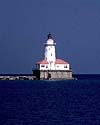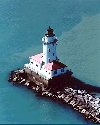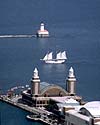 |
 |
 |
| Chicago Breakwater Light | Seeing The Light |
|
|
|
|
Historical
Information
As a result of the harbor's position at the foot of the lake, wave action driven by northeast winds would drive sand into the southern shore, keeping the waters shallow at the river's entrance. Schooners bound for Chicago were thus forced to anchor a half mile offshore, with their cargoes transferred to lighters, which would make the trip through the shallows to the docks at the river mouth. Responding to this problem, the Federal Government appropriated $25,000 for improvements to the harbor in 1833. Under the direction of the Bureau of Topographical Engineers, work on the harbor improvements began the following year with the dredging of a channel from the deep lake water to the mouth of the river. As the town grew around it, Fort Dearborn was decommissioned in that same year, its grounds to gradually transform into what would become Grant Park. By 1835 the work had progressed sufficiently to allow the one hundred-ton schooner ILLINOIS to enter the Chicago River. In 1837, with a population of 4,170 the town of Chicago was officially incorporated, work on a 1,1852 south pier was completed, and construction began on a 1,200-foot north pier to guard the opposite side of the new channel. The following year, the Federal Government appropriated $30,000 for additional harbor improvements. Unfortunately these harbor modifications were a complete disaster, as the lake's winds and currents forced sand through the harbor opening, restarting the silting process. When the City approached the Federal Government for additional funds, the response was unfavorable, and work on the project came to a halt in September of 1839. After considerable political wrangling on behalf of the city's political power brokers, Congress deeded federal land in the area to the City to be sold in order to raise additional funds. In 1843, Congress also made an additional appropriation of $25,000 to the project, and assigned Captain George B. McClellan to oversee the project. By 1844, the city's population had again doubled, and a total of $247,000 had been expended on improving Chicago's growing harbor. With the arrival of the first canal boat through the newly completed Indiana and Michigan Canal in 1848, the city became a shipping point for the bounty of the continent's mid section through the canal's connection to the Mississippi River system. By the end of the canal's first season, Chicago held the honor of becoming the nation's busiest port. In 1852, with the completion of an extension to the north pier, a new lighthouse was constructed at the pier's end, and the old 1832 structure standing by Fort Dearborn was decommissioned. As the 1870's dawned, Chicago's meteoric growth was unstoppable. The city's newest buildings and spreading park system were fast rivaling those of New York City. And then, without warning, all Hell broke lose.
With the coming of rain near midnight of the next day, the conflagration had consumed an area four miles long and almost a mile wide. Including over twenty-eight miles of streets, 120 miles of sidewalks, some eighteen thousand buildings stood in charred ruins. Recovery from the fire was both rapid and dramatic, and by 1875 little evidence of the disaster remained. The City's rebirth fostered an unprecedented lumbering boom along the eastern shore of Lake Michigan, with many towns such as Ludington, Whitehall and Manistee owing their very existence to supplying Chicago's insatiable hunger for lumber during its rebuilding efforts through the 1870's and 80's. In 1872, the Lighthouse Board decided to construct a new lighthouse at Grosse Point, and with the completion of the station's construction in 1873 it was determined that the existing light on Chicago's north pier was no longer necessary, and the pier light was decommissioned and subsequently dismantled. So proud were the citizens of Chicago of their beautiful new face and growing national and international importance, that they planned to host the World's Fair in May of 1893. Planned as a "White City," named for the white plaster of which the buildings were to be constructed, and sprawling along the waterfront, the Columbian Exposition would bring the world to Chicago, and in turn show Chicago to the world. To prepare for the expected influx of travelers attending the Exhibition, a number of harbor improvements were undertaken including the construction of a new lighthouse near the entrance of the Chicago River, close to the location of the original 1832 tower. The forty-seven foot tall structure was constructed of steel plates, and lined with brick. In order to eliminate the need for a separate keeper's dwelling, the living space was designed within the eighteen-foot diameter tower itself. Capped with a decagonal cast iron lantern room with vertical astragals typical of the period.
The lens featured alternating red and white panels, and had been ordered for installation in the new lighthouse at Point Loma California. However, with construction of the new Chicago harbor light completed at the same time as the closing of the Columbian Exhibition in October, the Lighthouse Board decided to keep the lens in Chicago, and thus the lens was installed in the lantern room of the new tower. Also at the close of the Exhibition, the magnificent skeletal tower was disassembled and shipped to Rawley Point just north of Two Rivers, Wisconsin, where it was reassembled and placed in service the following year. With a 1917 renovation of the breakwater off the harbor, it was determined that a light was needed on the structure to guide vessels around its southern extremity into the harbor. To avoid the expense of building a completely new structure, Congress appropriated $88,000 in June of that year to fund the relocation of the 1893 river mouth tower onto the breakwater.
While fully automated in 1979, the light still exhibits its prize winning Third Order Fresnel lens, and while most of today's vessels use Loran, Radar or GPS to find their way into the safety of Chicago Harbor, the proud tower still displays its reassuring beam to welcome mariners to the Windy City. Keepers of this Light Seeing this Light Finding this Light Reference Sources |
This page last modified 12/02/2007